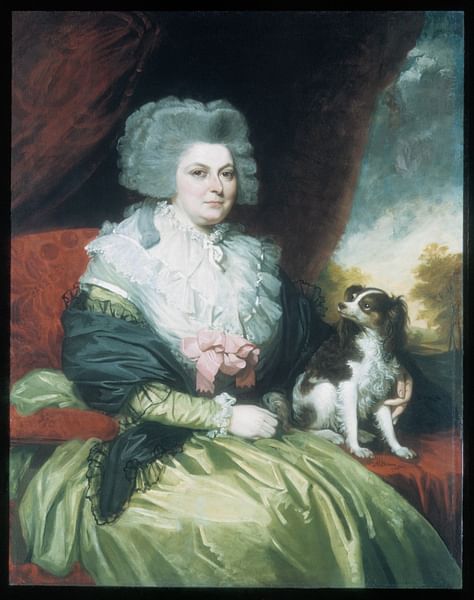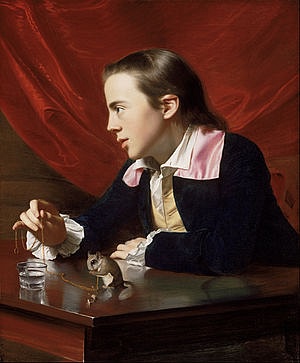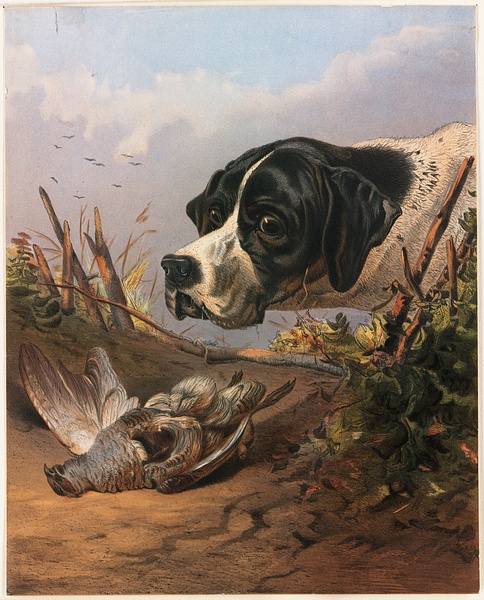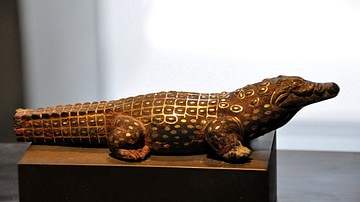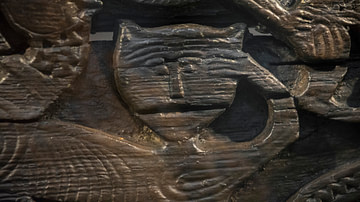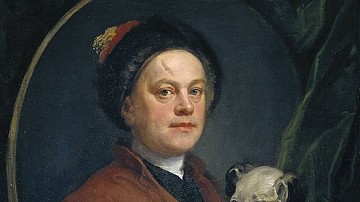Pets in Colonial America were kept by the colonists for the same reasons they were in Europe: for companionship and, in the case of dogs, for protection, hunting, and herding. Cats controlled vermin in homes and barns until the 18th century when they became valued as house pets.
The colonists kept many different animals as pets, however, including squirrels, wild birds, raccoons, deer, horses, snakes, frogs, and turtles, among others. The settlers brought their own dogs, horses, and cats from Europe and later tamed other animals – like deer, otter, and beaver – they encountered in North America.
Long before the arrival of the first Europeans, the Native Americans had also kept pets, primarily dogs and turkeys although there is evidence that bobcats were also domesticated. The Native Americans kept dogs for the same purposes as the colonists but also used them to transport goods via sledges attached to harnesses tied around their torsos. Early colonial accounts describe dogs being used in this way but, eventually, the natives adopted the dog collar from the Europeans and the harness was used less frequently.
Each tribe had different dog breeds used for different purposes in the same way they observed various traditions distinct from each other. There was no single Native American dog in North America. The colonists, on the other hand, were more uniform in their use of dogs – and pets in general – and the European model eventually became standard across the country. In the present day, pet owners still adhere to this same model observed in Colonial America.
Native American Dogs
Exactly when and where dogs were first domesticated continues to be debated but it is thought that they were not native to North America but arrived with Paleoindians who migrated into the land across the Bering Land Bridge (also known as Beringia) over 14,000 years ago. Scholar Marion Schwartz comments:
Dogs are remarkable because they are uniquely sensitive to the cultural attributes of the people with whom they live. Not only are dogs a product of culture, but they also participate in the cultures of humans. In fact, dogs were the first animals to take up residence with people and the only animals found in human societies all over the world. Because of the ubiquity across cultural boundaries, dogs have been so commonplace that their history seemed to warrant little consideration. And yet for the past twelve thousand years dogs have played an integral part in human lives. What is most remarkable about dogs is their ability to adapt to the needs of the people with whom they live. Dogs have proved themselves amazingly flexible beings, and this was as true in the Americas as elsewhere in the world. (2)
The first dog to enter North America is thought to be a kind of dingo, although this claim has been challenged, and it is possible there were a number of different breeds who arrived with the early human immigrants. Dogs were used to protect homes and villages, for hunting, transporting goods via sledges, and in the case of the west coast Salish breed (a larger version of the Pomeranian), their fur was used to make mats and blankets. Some tribes kept dogs as pets and also as a food source, others primarily as guardians and hunters, but all considered dogs as valuable assets.
Dogs were highly regarded as a gift from the gods, and although there are many different myths relating how the dog came to live among human beings, the story of the Dog and Great Medicine from the Cheyenne of the midwest is typical. The creator-god Great Medicine made human beings after creating the world and showed his people a land covered in fields of corn and thick with herds of buffalo. The Cheyenne appreciated the gifts but had no means of following the buffalo to hunt them or of transporting the corn once it was harvested. They were also sometimes attacked in the night by other tribes who could sneak up on them so even the small amount of corn and buffalo brought into the village could be taken. Great Medicine showed them how to capture young wolves to raise as pets. These animals then evolved into domesticated dogs who would warn the village of an attack, could transport corn, and would help the people track the buffalo as well as hunt other game.
In some tribal stories, the dog is among the first creatures created, in others, like the Cheyenne, it is a gift given to make life easier for the people. Dogs were considered intermediaries between the seen and unseen worlds, the realm of mortals and of the gods, as they embodied both the wild and the domestic spheres. This view of the dog contrasted sharply with the European understanding of the dog as a created being whose only purpose was to serve people.
Colonists & Their Dogs
According to the Christian Europeans, dogs had no souls – nor did any other animal – as an immortal soul animated only human beings who would answer for the deeds done in life after they died and appeared before the throne of God for judgment. The dog was therefore not viewed as anything special and references to dogs in the Bible encouraged this view as dogs are generally associated with poverty and low social status. To cite only one example, although the biblical tale of Lazarus and the Rich Man from Luke 16:19-31 has been interpreted as showing dogs in a positive light (as healers who lick the sores of the poor man), they are associated with poverty by this very act.
Even so, the colonists did not look down on dogs but cared for them deeply. The first law concerning mistreatment of dogs (or any animal) in the English colonies was the Regulation against Tyranny or Cruelty of the Massachusetts Bay Colony in 1641. Purposeful cruelty toward an animal was punishable by fine or a sentence in the stocks and pillories. Colonists who bred dogs, especially, took great pride in them and elevated their own above those of their neighbors with collars which were often ornate and, among the upper-class, quite expensive.
Leather collars with a brass plate engraved with the dog’s name, owner’s name, and sometimes a pithy epigram were popular in Europe and mirrored in early Colonial America. Dog ownership came to be associated with a degree of wealth in that one could afford to feed a dog as well as one’s family, and the padlock collar was developed, in part, to prove said ownership. The padlock collar was a hinged ring of metal attached around a dog’s neck by clasps and fastened with a small padlock for which only the owner held the key. If the dog were lost or stolen, one could prove ownership by producing the key and unlocking the collar as the piece was impossible to remove otherwise without harming the dog.
Dogs were used for hunting, guarding the home, and in blood sports such as dogfighting or bearbaiting. Breeds included various hounds, bulldogs, mastiffs, pointers, setters, spaniels, terriers, and others. Smaller breeds were known as “comfort dogs” and were favored by women and the elderly as companions. Upper-class gentlemen, such as George Washington (l. 1732-1799) and Thomas Jefferson (1743-1826), kept inventories of breeds and Washington prided himself on his knowledge of dogs. The French general Lafayette (l. 1757-1834), an ally of Washington’s during the Revolution recognized this and gave Washington two Basset Hounds as a gift; thereby introducing the Basset to North America. Another of the best-known anecdotes concerning Washington and a dog also comes from the period of the American War of Independence (1775-1783) and relates how, after the Battle of Germantown in 1777, Washington found the dog of his opponent, General William Howe (l. 1729-1814), and returned it to him with his compliments. Washington knew it was Howe’s dog from the inscription on the dog’s collar.
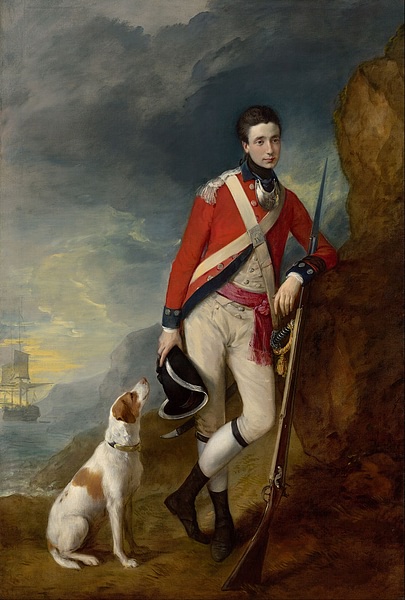
When a dog went missing, if they lacked identification such as Howe’s dog, advertisements would be posted at the local meeting house, church, or tavern offering a reward for its return, just as people do today. In Colonial Williamsburg, rewards for dogs were offered in the amount of 20 shillings (nine days’ wages) between 1774-1777 signifying the value owners placed on their dogs. Advertisements in New York City during the Revolution follow the same model as British officers posted many for the return of their lost dogs. Portraits of upper-class gentlemen of the time often show them posing with a favorite hunting dog and the same of upper-class women with their comfort dog. Dogs, in fact, begin appearing fairly regularly in family portraits from c. 1700 onwards.
Other Pets
Dogs were not the only domesticated animal to enjoy an elevation in status during the 18th century; cats also became more highly valued as companions whereas previously
they had been regarded more or less as utilitarian pest control. The Age of Enlightenment encouraged people to question many of the beliefs and traditions of the past, and among these was the view of the cat as almost a necessary evil. Cats were associated with pagan cultures and, it was noted, were mentioned nowhere in the Bible, making them suspect. They were useful in controlling the population of rats and mice, however, and were more tolerated for the most part than cared for.
During the 18th century, however, the cat became the pampered house pet one is familiar with in the present day. Family portraits as well as single-figure pieces frequently featured the person’s or family’s cat, and they began to appear in poetry and literature. The cat as a witch’s favorite familiar, of course, was widely recognized, and they were not embraced as family members as early as dogs were, but by the time of the American Revolution, they were on at least equal standing with dogs as far as portraiture is concerned.
Deer were also featured in portraits and became one of the most highly sought and popular pets of Colonial America. Deer wore collars and were walked on leashes and, based on their depiction in paintings, lived in the family home as comfortably as cats or dogs. Deer were frequently domesticated and let loose in the gardens of colonial estates to amuse guests at parties, and one example of this is a Dr. Benjamin Jones of Virginia Colony who trained over one hundred deer for his property for this purpose as well as for his family to enjoy. Portraits of deer show them in poses very like those of greyhounds of the period with brass colors often of the padlock type.
Another pet which was frequently featured in portraits was the squirrel whose young became more popular than a puppy or kitten with children of the time. People robbed squirrel nests of their young, domesticated them, and sold them in the marketplace as house pets. These house squirrels were collared, leashed, and walked just as comfort dogs were. Flying squirrels were especially popular with young boys who trained them to sit on their shoulders as they walked through town. The popularity of squirrels as pets was lamented by wives and mothers of the time, who complained the creatures chewed through closets, clothing, and linens and could not be contained because they could eat their way through wooden boxes or cages. Tinsmiths capitalized on this by creating metal cages with exercise wheels and other items inside so the squirrel could still entertain a family but remain contained.
Domesticated birds were especially popular with young girls and women, who kept cardinals and others in often elaborate cages in their drawing rooms. It was believed that one could teach a bird a tune by repeating it and so small flutes known as flageolets became popular among bird owners. The person would repeat a simple tune on the instrument throughout the day, and it was thought the bird would learn to sing it. There are no records of this practice actually succeeding, however, except in the case of the mockingbird.
Beavers were also popular, mainly among men and boys, and were trained to catch fish and carry them home. Otters were trained to retrieve game that fell into water, in the same way hunting dogs previously had been. Fishermen, especially, were fond of trained otters who would dive under the water and return with fish. Raccoons, which were also domesticated, were least popular owing to their habit of breaking-and-entering pantries and stealing food or various items from homes. No matter how well-trained, a raccoon was also apt to kill the family’s chickens, which eventually led to it being dropped as a pet and seen more as a predator and nuisance.
Other animals, such as snakes and small monkeys, continued to be popular even though they presented their own problems. Snakes were particularly unpopular among women, although women and girls were the primary owners of monkeys who were far more bothersome in maintaining a neat and clean home. Another animal popular especially among young girls was the lamb which was often depicted in paintings wearing a ribbon around its neck. Chickens, of course, also served as pets although no portraits feature them adorned as lambs and monkeys were.
Conclusion
Changes in pet ownership, concerning the types of animals kept in homes, came with the Industrial Revolution of the late 18th and early 19th century. The British industrialist Samuel Slater (l. 1768-1835) introduced English textile mills into the USA c. 1789. He was assisted by industrialist Moses Brown (l. 1738-1836) who established the first water-powered mill in America in Pawtucket, Rhode Island in 1790. The introduction of textile mills proved quite profitable for businessmen and encouraged the development of more labor-saving technology, which led to urbanization as people moved to cities for work. As industrialization and urbanization increased, pet ownership became more restrictive regarding choice; a city apartment was no place for a deer, horse, or lamb as a pet. Those in rural areas still kept these animals as pets, but they no longer appear in portraiture in the 19th century, and squirrels seem to have followed this same decline in popularity.
Colonization, westward expansion, and further immigration also affected which animals were kept as pets. Deer were regularly hunted as food and for their hides even as they were domesticated as pets, but as natural habitats began to shrink and deer populations moved further away from settlements, catching and domesticating a deer as a pet became less popular than shooting and eating one for dinner. The snake, so popular during the Colonial period, followed this same course as they were driven further away from towns and cities and finally became relegated to the sphere of entertainment by traveling magicians and circus performers by the mid-19th century.
As more land became settled, and more people needed to be fed, animals like beaver, otter, and raccoon – which had been hunted for their skin and meat even when they were seen as popular pets - came to be primarily seen as food sources instead of companions and assistants. Native American villages, which had once been quite numerous along the eastern seaboard of North America were destroyed by colonists to make room for further settlements, and once the inhabitants were relocated onto reservations, it was illegal for them to own dogs just as it was for them to have access to firearms. Native American dogs were confiscated, and these dog breeds eventually went extinct from breeding with European dogs and so thoroughly that it is unclear, today, what many of these breeds even were.
Restrictions on types of pets seem to have occurred naturally as more exotic animals became more difficult to come by. Dogs and cats, therefore, became the primary choice for most people, and their popularity grew as more homes adopted them. In the present day, the dog and cat continue to be the most popular and common animals kept as pets, although a number of Americans continue to keep exotic animals just as their ancestors did.
